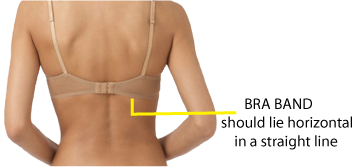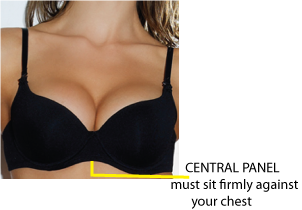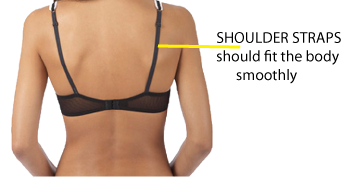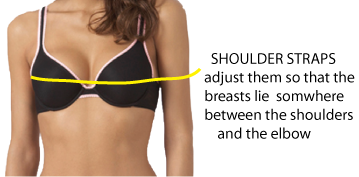A Properly Fitting Bra
Bra Band
A properly fitting bra band will allow a finger movement under it.
The bra band should enable unrestrained breath.
A correctly fitting bra is the one whose bra band lies horizontal in a straight line.
The bra band must snug around your body, comfortably. For a tight chest band you may need a larger band size, a bra extender or a looser hook placement.
The bra should feel comfortable while sitting. It should not feel as if it is cutting deep into your skin at the ribcage.
It should not ride up on your back. If it does, your band size is looser than your size.
The bra band should also not ride up across your breasts, unless it's loose.
If your bra band leaves loose bulges on the extreme sides of your back, know that the strap is tighter than your size.
A proper band size will let your bra stay in place even if you drop off your shoulder straps. Well, this may help you check if you are wearing the right band size.
The band size can typically be adjusted, using alternative sets of fastening hooks that are attached on the band strap.
Central Panel
The central panel, between the cups of your bra, must touch the breast bone and sit firmly against your chest, unless your cup size is not too small to accommodate your breasts properly.
Minimizer bras may also not achieve this effect.
It's best if the center panel between the cups of your bra sits firmly against your chest (sternum). However, this may not hold true for large breasts.
If the central panel has a gap, the style of the bra may not be working for you.
Cups
The edges of the cups must lie flat against your breasts. Go a cup size down, if visible gap is to be seen.
The cups sizes must accommodate and fill your breasts completely.
Too small a cup size may compress the breasts and force them to bulge out the sides while too big ones can wrinkle and pucker to give an unsightly look.
There should be no excess fabric in the cups. If there are visible wrinkles or unsightly ripples or bumps under your clothes, know that your cups size is greater than your size. Go a size down.
If the cups are too big to fill with your breasts completely, you may have bra straps that may often fall down your shoulders.
The breast tissue should not spill out of the cup at the top, bottom or at the sides. If your breasts are overflowing the cups, try a cup size larger or go for full coverage cups.
If the cup fits tight and uncomfortable, increase the cup size and not the band level.
Shoulder Straps
A properly fitting bra should have straps that fit the body smoothly and snug it comfortably.
Adjust your straps so that, ideally, your breasts lie somewhere between the elbows and shoulders.
Check that all the straps lie flat on your shoulders and are even.
There should be no buckling anywhere, and the straps should not dig into your flesh
Straps must remain in place. Straps should not dig into your skin. If it does, it's too tight for you. Neither should it be loose enough to slip off your shoulders.
The rear strap should not pucker or ride up.
There must be space enough to move a finger between the straps and your skin.
If the shoulder straps dig into shoulders, it means that the bra is not providing enough support to your breasts.
As a result the weight is being transferred, not to the cups and bra band but to the straps.
The straps should carry no more than 10% of the breast's weight. This may lead to many health problems like headache, back, shoulder and muscle pain.Women with large breasts should not wear thin or narrow straps. This may lead to muscle pain.
Bra accessories like Shoulder Ease may reduces the pressure bra straps put on shoulders.






